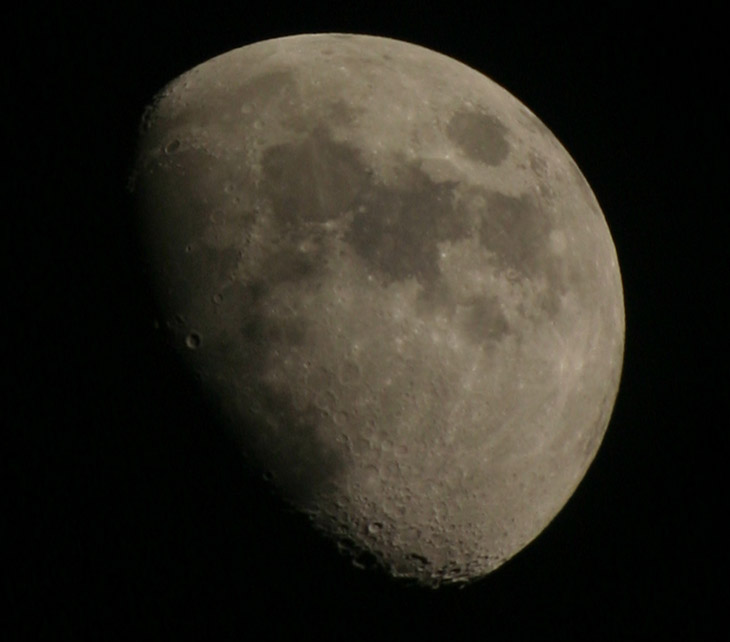
For some unknown reason, I have a desire to capture sunrise on Tycho, the prominent rayed crater on the moon. Since it’s unlikely I’ll be able to afford a trip there anytime soon, I’ve been pursuing this remotely, but what it means is capturing a particular phase of the moon at just the right time. Shown above, we have the moon from yesterday evening and tonight, showing the advancement of the phase in about 30 hours. I’ve remarked before, moon observations are usually much more interesting in any phase but full, since the oblique angle of the sunlight makes the rough terrain stand out better, throwing shadows that define details starkly. Note how different things look along the terminator, the shadow line, between the two images.
Now here’s the same image with some guide marks:

‘A’ is Tycho, though in the blue-sky image all you can see is the barest edge of the crater; a day later it’s fully defined. Don’t confuse it with ‘B,’ which is Maginus; well-defined in the earlier shot, it has reduced to a subtle outline in a day. Below that, invisible the day before, sits Clavius, where the moon base is.
Tycho has a large central peak, a strange artifact of large impacts, and my goal is to photograph it just as the sun is illuminating this peak, a bright spot in the darkness of the surrounding crater floor still in shadow. In the first image, the sun is only shining on the edge of the crater, but 30 hours later, it has advanced far enough that the peak is no longer throwing a shadow that I can discern with my longest lens.
Lunar days are 29.5 Earth days long, so sunrise takes a while but, obviously, the gap between my two photos was too much. Yesterday as I looked at the images I’d taken, I told myself I should go out a few hours later, not long before the moon set, and see what I captured then. Yet I ignored that voice, when it now seems likely that I could have captured just that image. One part of my brain is currently gloating “I told you so,” while the other part is muttering petty insults in return.
Anyway, there are still a few details that show nicely between the two. The small but deep crater that appears on the terminator of the latter image is Copernicus, sitting near the end of the curved mountain range known as the Lunar Appenines, much better defined in the earlier image. Towards the top, visible in both, is the crater Plato.
The sharply defined dark region at upper center, the one bisected by a brighter line, is Mare Serenitatis, or the Sea of Serenity. The brighter line is a ray from the crater right at the lower edge of the Mare, Menelaus. While the ray appears to continue out of sight towards the top of the moon, it actually intersects a ray from Thale crater at the upper edge, which cannot quite be made out in these images – it is, however, responsible for that bright region at top.
A quick bit of trivia while I’m on the subject. There is an account from 1178 of five monks that observed a peculiar effect on the crescent moon, the tip splitting into two and giving off “sparks.” For a while, it was suspected that the monks had witnessed the creation of the Giordano Bruno crater (not visible from earth – it was found by orbiters.) But recently it was determined that this was very unlikely; not only is the crater much older than that, the effect would likely have looked entirely different from what they described, and it would have resulted in a week-long meteor shower on earth. Any of those craters showing rays would have produced enough ejecta to escape the moon’s gravity and be captured by our own. I would dearly love for this to happen sometime in my lifetime.
You can use Google Earth to examine detailed images of the moon (look for the Saturn icon,) including some great videos from surveying satellites, but it’s also a little tricky. First off, all images are taken during ‘local noon’ which is a rotten way to define craters, making them hard to match up to images like this. Worse is the distortion that occurs as you zoom in, rolling details away and out of sight over the horizon quickly – the only time the proportions match what you see in my images is when the moon is zoomed as far away as possible. But check it out anyway.
Meanwhile, we’ll see what happens next month as daybreak on Tycho rolls around again…





















































